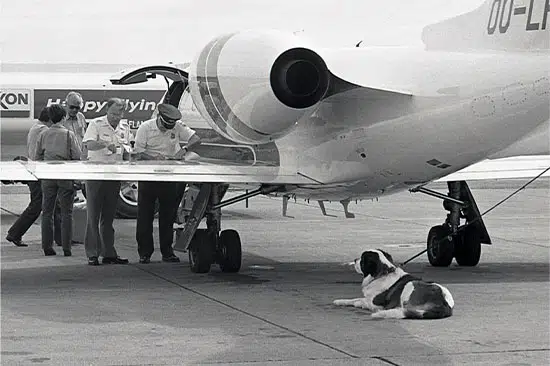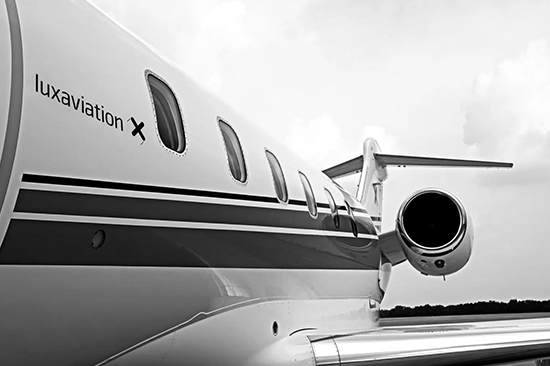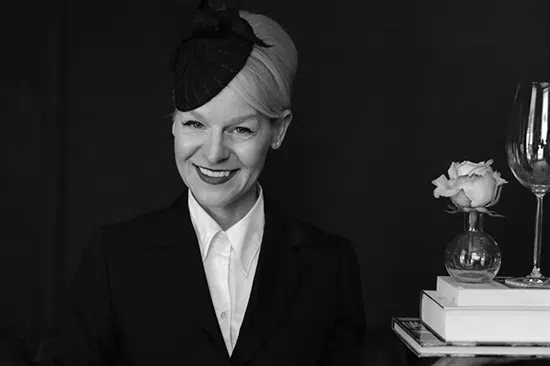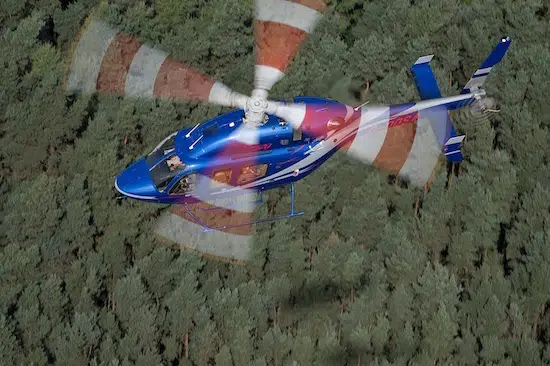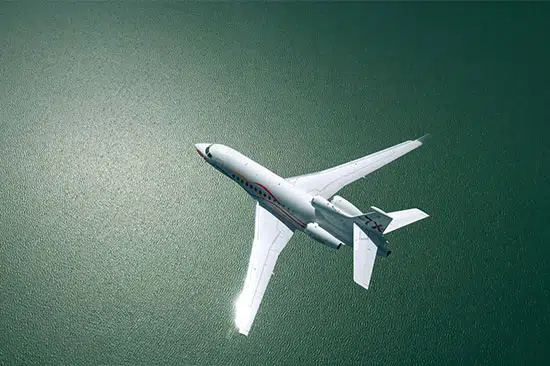F.A.Q.
At Luxaviation, we recognize that embarking on a private jet travel journey can raise numerous questions, whether you're an experienced jetsetter or new to the world of luxury aviation. Our dedicated FAQ page is designed to provide you with comprehensive insights, addressing every query you might have, and equipping you with the knowledge to make informed decisions that enhance your travel experience.
PRIVATE JET INFORMATION
Smoking on a private jet is often not permitted due to safety concerns. However, the rules regarding smoking on a private plane can vary depending on the operator, the country you are in, and the type of aircraft you are flying on.
It's important to note that smoking on a private jet without permission is inconsiderate and illegal in many jurisdictions. Suppose you need clarification about the rules regarding smoking on a private jet. Checking with the operator or charter company beforehand is best to avoid misunderstandings or extra costs. The cleaning fee can vary depending on the extent of the smoke damage, but it can be quite expensive. Additionally, it is highly likely that the private jet owner might not like travelers smoking in the plane.
The range of a private jet depends on factors like the aircraft type, weight, and fuel capacity. Light jets, such as the Cessna Citation CJ3, can cover around 2,400 miles non-stop. Midsize jets, like the Hawker 750, have a range of up to 3,500 miles. Large cabin jets, such as the Dassault Falcon 2000 Series, can travel up to 4,600 miles without refueling. For longer distances, there are long-range aircraft available, such as the Gulfstream G650, which can fly over 7,000 miles non-stop. So, when you consider chartering an aircraft for travel, have an idea of the intended flight route and the total distance to your desired location.
Yes, a private jet can, like airlines, fly internationally. Private jets can fly long distances and are often used for international travel. Nonetheless, specific regulations and requirements must be met for international travel, such as obtaining the necessary permits and documentation, complying with customs and immigration procedures, and meeting the applicable safety and security standards. Also different countries may have different rules and regulations for private jet operations. So consulting with a professional aviation service provider is essential to ensure compliance with all applicable laws and regulations.
Private jets fly at an average speed between 400mph and 750mph. At a top speed of 711 mph, the Cessna Citation X is amongst the fastest private jets in the world; other private jets like the Gulfstream G-650 and Dassault Falcon 7X can also travel at speeds of up to 685 mph. Other factors that can determine the speed of a private jet include the aircraft's weight, type, weather conditions and performance limits.
Private jets can land at any airport with a runway long enough to accommodate their size and weight and where the airport authority has granted permission to land. Some airports may require advance notice or permission for private jet landings and may restrict the times of day or days of the week when private jets can land or take off.
However, some locations, such as remote areas or certain countries, may have limited or no infrastructure to support private jet operations and may require special permits or clearances to land. It's important to consult with an aviation specialist or operator before attempting to land a private jet in an unfamiliar location.
The number of people that can fit in a private jet depends on the size and model of the aircraft. Small jets like the Cessna Citation Mustang or the Embraer Phenom 100 can typically carry 4-6 passengers, while midsize jets like the Hawker 800 or the Gulfstream G150 can carry 8-9 passengers. Large jets like the Gulfstream G550 or the Bombardier Global 6000 can carry up to 18 passengers. Business Airliner such as Airbus A320 VIP can seat 26 passengers. Some ultra-long-range jets like the Boeing Business Jet or the Airbus ACJ319 can accommodate even more passengers, up to 50 or more, depending on the configuration.
Yes, dogs can travel by private jet too. As opposed to commercial airlines, where they would be in the cargo hold, a private jet would allow your pets to sit next to you in the cabin. Additional costs and cleaning fees are associated with bringing your dog on board. The cost and prices will vary depending on the private jet company and the size of your dog. Specific requirements for getting your dog on board include providing a health certificate or proof of vaccination. It would be best to inquire about the charter company's needs to ensure you have all the necessary documentation before boarding the private jet with your dog. For more detailed information on pet travel by private jet, please visit our Pet Travel Page.
With a price tag of $600 million, Air Force One, a renowned embodiment of the US presidency, is also the most expensive private aircraft in the world. It is a Boeing 747-200B and is designated VC-25A by the Air Force. This private jet's interior has luxurious amenities like a conference room, an onboard medical facility, and several bedrooms. Although the plane has room for 480 people, it is only set up to accommodate 70 passengers in lavish comfort.
LUXURY TRAVEL AND DESTINATIONS
Luxury travel refers to experiences denoted by exceptional comfort, exclusivity, and personalized service. It involves high-end accommodations, top-notch amenities, and unique, immersive experiences tailored to the traveler’s preferences and interests. Luxury travel can take many forms, from a private jet charter to a safari in Europe, America, and Africa, a ski trip in the Alps, or a five-star resort on a tropical island. Luxury travel is about creating memorable experiences that allow you to unwind, rejuvenate, and indulge in the finer things in life. But, it's worth noting that private jets serve as more than just leisure aircraft. They are also valuable work tools, enabling real-time optimization and efficiency for businesses and professionals. With the flexibility and convenience of private jet travel, individuals can optimize their travel schedules, reduce travel time, and enhance productivity.
A private jet costs between $2,000 and $11,000 for every billable flying hour. These hourly prices cover various aircraft, from the best executive jets to turboprops. For example, a light jet like a Learjet 75 Liberty or Embraer Phenom 300E typically costs between $1,200 and $3,000 per hour, while a mid-size jet like an Embraer Praetor 600 or a Citation Sovereign can cost between $3,500 and $5,500 per hour. Large jets such as a Gulfstream G650 or a Bombardier Global 7000 can cost $7,000 to $10,000 per hour or more. To receive an accurate quote estimation, please make your request here.
We typically offer discerning travelers high-end travel experiences, including private transportation, luxury accommodations, personalized itineraries, personal concierge, adventure travel, and unique experiences.
The incredible, most-wanted destinations to visit on a luxury vacation in 2023 include Las Vegas, United States, London, United Kingdom, St. Moritz, Switzerland, Nice, France, Dubai, United Arab Emirates, Aspen, Colorado, Ibiza, Spain, Mykonos, Greece, Maldives, Singapore, Seychelles, Bali, Indonesia, Bora Bora, French Polynesia, Santorini, Greece, Queenstown, New Zealand, Maui, Hawaii, Phuket, Thailand, The Amalfi Coast, Italy.
Some of the ways we can offer a truly luxurious travel experience include but are not limited to uncompromising standards, travelling in style, attention to detail, fine dining, indulgent accommodation and personalized service.
PRIVATE JET COSTS AND OWNERSHIP
A private jet can cost between $2.5 million to $700 million. The cost of a private jet varies widely depending on several factors, including the model, size, and aircraft features. Also, your country, taxes and fees associated with owning and operating a private jet, maintenance, fuel, and other operational costs can add significantly to the overall expense of owning a private jet.
Yes, we have luxury private jets for sale. However, the availability and pricing of these jets depend on several factors, such as the make and aircraft model, age, level of customization, and condition. It's worth noting that purchasing a luxury private jet is a significant investment, and buyers should carefully consider all aspects of ownership before purchasing. This includes ongoing maintenance, operational costs, and any regulatory requirements such as insurance and permits.
If you are considering purchasing a private jet, a step-by-step guide is to select a trusted aircraft acquisition specialist, determine your budget, decide on a new or used one, choose a manufacturer, inspect the aircraft, check maintenance records, arrange financing, close the deal then register the aircraft.
The cost of maintaining a private jet depends on several factors, including the aircraft's age, the plane's size, the number of flight hours, and the type of maintenance required. In average, you can expect to spend between $500,000 to $2 million annually to maintain a private jet. Some maintenance costs associated with owning a private jet include hanger fees, routine maintenance, unscheduled maintenance, avionics, pilot training, and insurance.
Yes, it is possible to buy a private jet if you have the financial means to do so. Private jets can range in price from a few million dollars for smaller models to hundreds of millions for larger, more luxurious models. Also, various legal and regulatory requirements come with owning a private jet, such as obtaining the necessary permits and complying with aviation safety regulations. It may not be a feasible option for everyone, but for those who can afford it, owning a private jet offers a convenient and luxurious mode of travel.
EMPTY LEG FLIGHTS AND AVAILABILITY
An empty leg flight is a private jet charter flight that occurs when a private jet is flying without any passengers. This happens when the jet needs to reposition itself for its next scheduled flight or has dropped off passengers at their destination and is returning to its home base.
You can find empty leg flights by contacting private jet operators, searching online, and signing up for alerts. One easy way to find empty leg flights is to use Twitter and the hashtag #emptyleg. For more detailed information on how to find empty leg flights, please visit our article here.
The empty leg flights are often available at discounted prices as the operator seeks to recoup some of the costs of the original charter. They are typically priced about 50%-75% lower than the regular charter.
To book an empty leg flight with Luxaviation, browse the available empty leg flights by location and date. You can contact their customer service team for assistance if you encounter any issues while booking.
Empty leg flights are not always available and can change quickly. Since these flights are often last-minute, planning your travel itinerary around them may take time and effort. Empty leg flights can offer flexibility in departure times and destinations since they are often scheduled based on the needs of the aircraft rather than the needs of passengers. However, if you are flexible with your travel plans and willing to put in the effort to find a good deal, booking an empty leg flight can be a cost-effective and luxurious way to travel.
PRIVATE JET SERVICES AND AMENITIES
Our private jet charters provide the peak of luxury with upscale features, including luxurious lounges, haute cuisine, spacious seating, and opulent cabins. Also, our clients can travel anywhere without dealing with crowded airports or commercial airlines. Other services we offer include, aircraft management, aircraft sales and FBO (Fixed Based Operator).
Additional passengers translate to fuel surcharges, more catering and amenities, and increased overnight expenses. You are advised to contact us first to discuss these additional costs to understand the total cost of adding more passengers to a private jet charter.
Additional costs depend on overnight parking fees, crew expenses, and landing fees. Fortunately, we provide a detailed breakdown of all costs associated with your charter, including any fees that may apply for an extra overnight stay.
Yes, our heavy and ultra-long-range (ULR) aircraft are equipped with Wi-Fi, allowing you to stay connected even while in the sky. The additional costs for using Wi-Fi vary depending on the aircraft and specific service provider.
Yes, flight attendant cost is included in large jets. However, the price can be an add-on or a separate cost when some clients require or desire the unique services of a flight attendant, and those who do may have specific preferences for their level of service.
Yes, some of our charter flights include access to a private lounge (FBO) or VIP lounge as part of the charter package, while in some cases outside EU, we offer it as an additional service at an extra cost. It's our necessity always to clarify what is included in the price of the charter to avoid any surprises or unexpected charges.
Yes. Food is often included in private jet charter prices, but it depends on the specific charter flight and package you select. Some packages offer basic amenities such as water and light snacks, while others offer full meal service with gourmet cuisine and beverages.
The catering options for small aircraft (Citation Jet/King Air) provide sandwiches, salads, snacks, and an open bar (water, selected beer, selected wine, cafe, tea, etc.) Large aircraft and premium packages (Dassault Falcon and Gulfstream) offer 1st class VIP catering up to clients' requests.
Yes. However, the level of assistance and equipment available will vary depending on the aircraft and the package. Some of our aircraft have features such as wider doors and larger cabins designed to accommodate passengers with mobility impairments, including those requiring a wheelchair. These aircraft may also have specialized equipment, such as lifts or ramps, to assist with boarding and disembarking.
AIRCRAFT MANAGEMENT AND OWNERSHIP
Private jet management is overseeing and maintaining a private jet for an individual or a company that owns it. Private jet management services provide comprehensive support for the aircraft owner, ensuring their plane is well-maintained, adequately insured, and meets all regulatory requirements.
Currently, we have our self-developed Luxaviation App which benefits our charter clients from booking charter flights and empty-leg flights in an efficient and seamless way. The features for our aircraft owners will also be added soon. It will provide a view of all the aircrafts’ information including upcoming maintenance, schedule, location, performance, carbon off-set information and so much more. Stay tuned.
Yes, a private jet charter usually needs the owner's consent. The final decision about whether or not to approve an aircraft charter rests with the aircraft's owner, who may also have additional conditions or requirements that must be satisfied. To ensure that all necessary approvals are secured prior to the flight, the charter broker will work with the owner or their representative to negotiate the charter's terms.
Yes, we do have the insurance certificate as well as the AOC (Air operator certificate) since it's a lawful necessity for commercial air transport operation. Additionally, we have a total of 15 AOCs worldwide.
Some key tasks in our private jet management include maintenance and repairs, flight planning, crew management, fueling, and scheduling. We also handle all aspects of the aircraft's operations, including arranging for hangar space, necessary permits and authorizations, and providing access to a network of airports and FBOs (fixed-base operators).
PRIVATE AIRCRAFT DETAILS
Private jets can be categorized into very light jets (VLJ), light jets, midsize jets, super midsize jets, business jets, long-range jets, ultra-long-range jets, and executive airliners. Notably, each category has its unique specifications and features. You can check more information on our fleet page.
Our jets generally are an average of eight years, implying they are new. It's worth noting that age alone doesn't necessarily determine the safety or quality of an aircraft. Our regular maintenance and upgrades always keep our fleet in excellent condition. Additionally, our company is typically subjected to strict safety regulations and must adhere to rigorous maintenance and inspection standards to ensure the safety of our passengers.
You can find them on our fleet page on our website.
Small aircraft, especially those designed for shorter flights or recreational purposes, do not have a toilet on board due to space and weight limitations. However, some small private jets ideal for regional flights may have a small lavatory compartment installed.
PRIVATE HELICOPTER CHARTER
The cost of chartering a private helicopter can vary widely depending on several factors, including the type of helicopter, flight length, number of passengers, destination, and the level of luxury and amenities desired. You can expect to pay from $1,000 to $3,000 per hour for a private helicopter charter. Regardless, this is approximated cost, and prices can range from as low as $750 per hour for a small utility helicopter to upwards of $10,000 per hour for a larger, more luxurious model.
Choosing a helicopter or a private jet depends on several factors, including travel needs, budget, and personal preferences. A private jet is ideal for longer trips. They are the best option because of the range and offer more amenities than helicopters, such as showers, galleys, and bedrooms. On the other hand, a helicopter is suitable for short trips since it can land anywhere where space allows and the versatility it comes with.
To charter a helicopter, you will need to inquire about a charter flight. This will include your name, contact information, and a list of the dates and times you would like to use the helicopter. After reviewing your application, we'll ensure we can satisfy your request. Upon confirmation, we will provide you with a quote and then book your flight.
Landing a helicopter on private property will depend on local zoning laws, land use regulations, and any applicable restrictions or agreements with the property owner. It is always advisable to check local laws and regulations and obtain the necessary permissions and permits before attempting to land a helicopter on private property.
Smaller, single-engine helicopters have a range of around 300-400 miles (482-643 km) before refueling. Larger, twin-engine helicopters can fly further, with a range of up to 1,200 miles (1,931 km) or more. However, this can vary greatly depending on the specific make and model of the helicopter, its fuel capacity, weather conditions, and the cargo's and passengers' weight.
The number of passengers depends on the size and model of the helicopter. Small to medium size helicopters like Robinson R66, Bell 407, or the Eurocopter AS350 typically seat between four to six passengers (excluding the pilot). There are also larger executive helicopters, such as the Sikorsky S-92 Airbus H160 or the AgustaWestland AW139, which can accommodate twelve to nineteen passengers depending on the configuration.
SPECIAL CATEGORY PASSENGERS:
For unaccompanied children, the flight crew or in-flight service personnel will provide the following information:
- Who will assist with the operation of the seat belt and the fitting of the oxygen mask if the situation requires it.
- The content of the passenger safety briefing card.
- In case of evacuation, to seek the assistance of a crew member.
The information will be provided during the boarding and seating process.
The flight crew or in-flight service personnel will offer the following guidance to adults travelling with an infant:
- The brace position for an adult holding a lap-held infant.
- The use of the loop belt for a lap-held infant.
- How to fit their own oxygen mask before fitting the infant’s oxygen mask.
- How to evacuate while carrying an infant:
- On land, see EASA SIB 2013-06 on the evacuation of infants on aircraft equipped with inflatable slides or hatch-type overwing exits.
- In case of ditching, how to fit and when to inflate the infant flotation aid (e.g., life jacket, flotation device).
The information will be provided during the boarding and seating process.
The flight crew or in-flight service personnel will:
- Advise the SCP (Special Category Passengers) to leave their mobility aid behind in an emergency evacuation.
The information will be provided during the boarding and seating process.
The flight crew or in-flight service personnel will offer the following guidance to the accompanying passenger:
- Fit the life jacket on the SCP in the event of a ditching evacuation.
- Put on their own oxygen mask before fitting the SCP’s oxygen mask in the event of decompression.
- Secure or release the SCP’s seat belt if necessary.
The information will be provided during the boarding and seating process.
The flight crew or in-flight service personnel will offer the following guidance to the SCP:
- The location of the nearest suitable exit.
- That mobility aids may not be accessible during an emergency evacuation.
This information will be provided during the boarding and seating process.
The flight crew or in-flight service personnel will offer the following guidance to the accompanying passenger for securing or releasing the SCP’s seat belt, as well as to the SCP:
- In case of an evacuation: the location of the nearest suitable exit.
- In case of a ditching evacuation: the accompanying passenger should fit the life jacket on the SCP.
- In case of decompression: the accompanying passenger should put on their own oxygen mask before fitting the SCP’s oxygen mask.
This information will be provided during the boarding and seating process.
The flight crew or in-flight service personnel will offer the following guidance to visually impaired passengers, based on their level of impairment:
- How to operate the seat and seat belt.
- The location of the nearest exit (e.g., number of seat rows to the exit).
- Oxygen mask deployment.
- Location of the life jacket.
- The brace position.
- The cabin crew call button's location.
If available, crew may use aircraft demonstration equipment to provide tactile assistance. This information will be shared during the boarding and seating process.
The flight crew or in-flight service personnel will offer the following guidance to visually impaired passengers:
- How to evacuate their guide dog by holding the dog.
This information will be offered during the boarding and seating process.
The flight crew or in-flight service personnel will offer the following guidance to the stretcher occupant and accompanying passenger during boarding and seating:
- Evacuate the stretcher occupant only when the cabin area is clear.
- Evacuate without the stretcher, if possible.
- In the event of ditching, fit a life jacket on the stretcher occupant.

